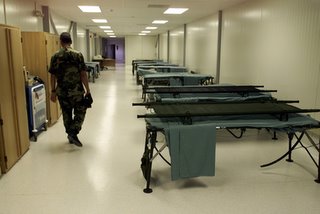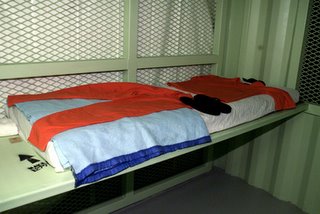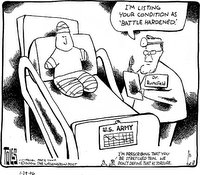It's nice to know that the "reality-based community" is alive and kicking over at the Times. If you needed any further proof to be glad that we have military professionals to make decisions instead of the editorial board of the Times, I offer
this editorial as exhibit A. It's basically a screed against those damn greedy "military contractors" and the two services that we all know are doing
absolutely nothing in the war on terror, the USAF and the Navy. The NYTimes would apparently rather us spend a very large chunk of our military budget on the Army, and not to buy equipment, but to increase the troop levels. Fine, they can have that viewpoint. But they really shouldn't use lies and revisionist history to support their ideas.
For example, the editorial makes reference to the fact that:
"The prospects for Iraq might be very different today if Mr. Rumsfeld had listened to some of his own senior generals and occupation officials and authorized significantly larger ground forces from the beginning."
That's true, to a point, but I was under the impression that the prospects for Iraq weren't too bad. I mean, all things considered, to have gone from a third-world dictatorship run by one of the worst thugs on the planet to a somewhat democratic open society with a Constitution in only 3 years is rather impressive, all things considered. But anyway, that isn't really a lie, just some creative extrapolating of the future. Regardless, I'll give the Times the fact that yes, more troops probably would have been nice. An easy button that lets us take out the terrorists magically with no collateral damage and some sort of Neo-like device to stop bullets in their tracks would be nice too. Anyway, on to the real lies...
"The early looting might have been contained before it shattered political confidence and vital infrastructure. The insurgency might never have gotten a head start. The incineration tactics of Falluja and the Abu Ghraib nightmare might have been avoided. And the Army's downward spiral of readiness, recruitment and morale might never have begun."
Looting wasn't a troops issue, it was a political/military decision making issue. If the decision had been made, the troops in-country would have been able to handle the situation. Granted, more civil-affairs troops would have helped, but raising the numbers in one particular MOS takes time, and as the Times references, the "generals and senior occupation officials" only raised the issue of more troops "at the beginning," not 5 years before the beginning. Bottom line is that I agree the decision to deal with looters was a mistake, but to pin the blame for that decision on troop levels is revisionist history (i.e.- SOP for the Times).
A similar case as above could be made for the insurgency. Civil-affairs troops would have helped, yes, but again, that was a decision that needed to be made years in advance, not something that could have been fixed at the "start." And now we get to the REALLY good stuff...the "incineration tactics of Falluja and the Abu Ghraib mess."
Oh, where to begin, where to begin...it appears the Times didn't get the memo about Willie Pete. It isn't a chemical weapon, and if we didn't use WP, we'd have to level houses instead of burning people out of them without damaging the house. In any case, it isn't "incineration," and the only possible way this relates to troop levels is that the Times wants use to use neither WP or HE and instead clear out every single house using infantry without any sort of artillery, tank, or air support. In that case, we would in fact need more troops, because we'd have taken many more casualties. But hey, why use a "chemical weapon" that might, in fact, kill our enemies when we can spend more money to get more troops so more troops can die. As for Abu Ghraib...I really, for the life of me, cannot figure out how troop levels are related to the actions of a few depraved individuals. I guess the only possible explanation is that we didn't have enough prison guards and that the soldiers who were guarding Abu Ghraib weren't properly trained....but wait, I thought that the orders for the torture came direct from the Neo-con cabal, in which case troop levels, in fact, would not matter. I dunno; like I said before, their arguments make little sense to me.
Finally, the Army is apparently in a "downward spiral of readiness, recruitment, and morale." Readiness, maybe. But that's what happens in wartime. Troops are going to be deployed, and they aren't going to have as much time to train. Recruitment is debatable. And morale...well, I guess the fact that soldiers are
re-enlisting at record rates is a sign of low morale.
So, moving on, we get to the part of the article where the Times starts slamming on my lovely service (along with the squids):
"Instead of reallocating resources toward the real threats America faces, the military services continue to pour their money into fighting fictive superpowers in the wild blue yonder and on and below the seven seas."
For once, to a point, I agree with the editorial. It is rather pointless to keep acting like we're fighting the Cold War when we obviously are not, and in fact are fighting a completely different war. Also, I have an extreme problem with the culture of the Pentagon and the belief that all weapons systems should be funded. So the rest of this article should not be construed to mean that I completely support any and all defense expenditures, especially expensive high-tech ones. And I've
blogged about this before(way before the NYTimes decided to write about it, by the way).
All that said, let's look at what the Times has to say:
"It (the Pentagon) also decided to splurge on a new nuclear attack submarine for $2.6 billion and to shell out $5.5 billion for separate Navy and Air Force versions of new stealth fighter jets, plus another $5.5 billion for yet a third version that either can use. In all, the Pentagon is asking for $84 billion to buy weapons systems (twice what it got in 1996) and $73 billion more for research and development."
Let's take them one at a time: first, the new nuke boat. It's the Virginia-class, and the simple fact of the matter (on both this, and the F-35 JSF which I'll get to in a moment) is that the military currently is using old equipment. There's no too ways about it. The Navy is currently using ships that were largely designed in the '60s and '70s and built in the '70s and '80s. They've been modernized, yes, but they are still ships pushing 20 years old. The Los Angeles class attack subs that the Virginia will be replacing are no exception. In fact, the Virginia-class will have extensive special operations capabilities, much better than the LA-class, which may seem inconsequential, but is just one more improvement over the current class.
Next up is the F-35 JSF. The main criticism here seems to be that the USAF and USN are buying separate versions of the airplane and then paying more to buy one that they both can use. While on the face of it this seems absurd, the two separate version are both CTOL (Conventional Takeoff or Landing), while the one that "both" can use is a V/STOL (Vertical/Short Takeoff or Landing) model. CTOL means the aircraft takes off and lands normally, with a take off and landing roll. V/STOL means that the aircraft can take off and land vertically, or with a significantly reduced take off roll. The Harrier is the best known example of a V/STOL fighter. The reason both models must be bought is that the V/STOL version, while still having supersonic capability, has slightly lower performance levels than the CTOL version. However, the V/STOL variant gives that extra capability and will also offer large performance gains over the current V/STOL fighter, the Harrier II. Also, if you were wondering, the reason the USAF and USN need separate CTOL models is that the USN model needs specialized equipment and a beefed up landing gear and arrester hook, meaning its performance is slightly less than the USAF model.
In any case, what the Times op-ed misses is that all 3 models are variants of the same aircraft. 20 years ago, the services would have bought completely different aircraft, costing even more money. Doesn't really surprise me that they leave out this fact, along with the facts regarding the three variants, since it is an op-ed, but a little intellectually honesty would be nice...even from the Times.
As referenced above, the military is using old equipment, which makes this paragraph particularly intellectually reprehensible:
"In all, the Pentagon is asking for $84 billion to buy weapons systems (twice what it got in 1996)"
First, we have an oblique reference to the Clinton years, when everything was hunky-dory and those nasty Islamic extremists simply didn't exist. Next, we're in the middle of a weapons replacement cycle. The Virginia class, the Raptor, and the JSF are all coming online. No major weapons systems were coming online in '96. I see no logical reason why the procurement budget might be a little higher this year than in 1996. Do you?
Finally, we have the wrap up:
"This budget would be wasteful even under a worst-case assumption that had a second superpower arising within the lifespan of these weapons, turning hostile to America and arming itself to the teeth with the most advanced weapons. There's still unnecessary spending that could be used to repair the Army, which has been ground down at least as much by Pentagon miserliness as by Iraqi insurgents."
I couldn't agree more with this paragraph. This is true of ANY military budget. However, the Times doesn't connect their two arguments. The first seems to be that any military expenditure to procure new weapons for the USN or USAF is bad. The second argument is that regardless of how you feel about the weapons programs they listed, we can all agree that there is unnecessary military spending. The second argument is fine; I agree with it. But if the Times agrees with it, why not take the time in this editorial to point out the weapons systems and procurement options that it would have a problem with regardless of who our enemy is? Why highlight the extremely necessary programs that are replacing old equipment?
I think we all know the answer to that.
Thanks to Mudville's
open post.



















